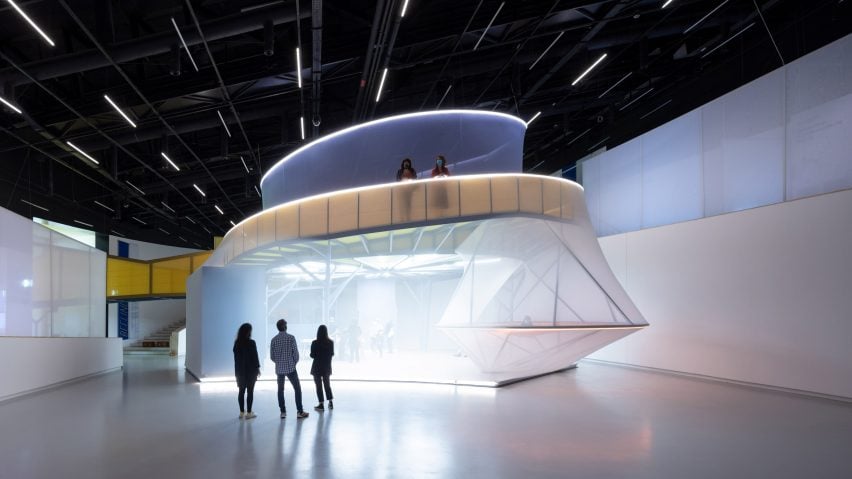The Amanda Levete-designed Museum of Art, Architecture and Technology in Lisbon has reopened following coronavirus lockdown with architecture studio SO-IL's Beeline installation creating a shortcut through the building.
The museum reopened to the public with SO-IL's installation in place on 10 June following a two-month closure due to the coronavirus pandemic.
The Beeline installation, along the Currents – Temporary Architectures by SO-IL exhibition, was due to open to the public on 27 March. As this was not possible both the installation and exhibition were brought to life digitally as part of a collaboration with Dezeen's Virtual Design Festival.
Now installed, the Beeline intervention allows pedestrians to walk from the MAAT's secret rear entrance on the city side to its main entrance on the waterfront, passing through the museum's main exhibition space.
"Most visibly the installation bisects the building by opening up a second temporary door through the backside of the museum facing the city, further to the one that normally people access from the river," explained MAAT executive director Beatrice Leanza.
New York architecture firm SO-IL has transformed the museum's interiors into a series of walkways and exhibition areas divided by fabric partitions.
"As a design gesture that takes over the entire museum, it significantly subverts the way it is normally experienced by taking audiences through elevated pathways, through differently sized gathering areas and display structures that prompt audiences to actively design their own experience," continued Leanza.
"It is turning the museum, both conceptually and physically, into a landscape of encounters with people, ideas and conversations."
To allow the MAAT to reopen the museum has installed a series of measures to ensure that social distancing is enforced, with only 161 people allowed in the entire building at one time.
"We did not have to modify anything from the original design of the installation," said Leanza.
"But we had to put in place preventive measures such as making the use of masks mandatory, install sanitisers at all entrances, and establish one-way circulation paths inside our spaces to guarantee a smoother movement of people and to respect the maximum capacity of each room in the space."
SO-IL created an auditorium at the centre of installation to host a series of public events called MAAT Mode.
These events took place online while the museum was closed, but will now happen in the custom-designed space.
"From now on we will operate in a hybrid manner, hosting programs on-site and online at the same time," explained Leanza.
"We are going to start experimenting also with new formats of on-demand content making, which we hope to continue in the future as a new avenue of practice for MAAT and of collaboration with creatives. If anything we have taken this challenge as an opportunity to improve and upskill our own tools and test ideas."
As part of Virtual Design Festival, Leanza and Florian Idenburg and Jing Liu of SO-IL spoke to Dezeen in a live interview. The interview was part of our VDF Screentime series, which has also featured interviews with Parley for the Oceans founder Cyrill Gutsch, architect Farshid Moussavi and designer Lee Broom.
Photography is by Iwan Baan.

